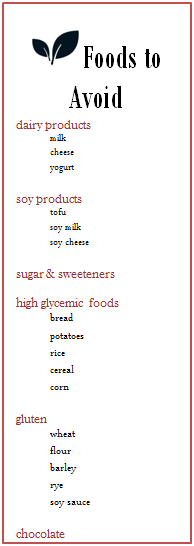Intolerance versus Sensitivity:
When it comes to negative reactions to food, you’ve got two broad categories: an allergy/intolerance or a sensitivity. If you’re allergic to a food, your allergic reaction will tend to show up pretty quickly after eating that food. You’re also likely to experience the typical symptoms of an allergic reaction: hives, vomiting, diarrhea, itching, swelling, closing of airways – that sort of thing. Most of us who think that our skin issues are linked to diet aren’t actually allergic to the foods we’re eating, but we may have a sensitivity.
A sensitivity can be marked by over 100 different sorts of symptoms, and the symptoms tend to show up days after you actually consume the food. An example of this which has recently come into light is the case of Celiac Disease. You may know someone with Celiac Disease, which is marked by a serious intolerance (practically an allergy) to gluten. However, in 2011, The Wall Street Journal featured a study from the journal BMC Medicine which highlighted the fact that “…we have scientific evidence that indeed, gluten sensitivity not only exists, but is very different from celiac disease.”
Given that a food sensitivity or mild intolerance can lead to over 100 symptoms in some cases, it’s likely that acne is one of them. Others can include fatigue, stomach upset, headache, depression, and numbness – classic ways that the body will try to tell you something’s wrong.
Do I Have a Sensitivity?:
If you have stubborn acne that is unresponsive to the generic list of treatments, creams, pills, etc. – then perhaps you have a sensitivity to certain foods. Of course, it would be incredibly convenient if you could just do a simple blood test to determine what foods you’re sensitive to. Unfortunately, there doesn’t seem to be an easy, reliable, and agreed upon test for this. Doctors argue about which tests are even accurate, and some of these might end up costing you quite a bit.
That’s why I suggest a Restricted Diet as the best way to figure out if you’ve got a sensitivity, and what exactly that sensitivity might be. I’ve found that there are two ways to structure a restricted diet:
Method One: This first way is the one which I prefer the least, but it will be the best way for some people. The basic plan is to take out foods you suspect that you might be sensitive to, just one food at a time. Each time you take out a certain food from your diet, you need to leave it out for at least 2-4 weeks in order to see results and to make sure that they’ll have a lasting effect. Once you find the food that the culprit, leave it out from you diet indefinitely. By using this plan, you can keep eating most of the foods that you enjoy while trying to find the root of your symptoms. The only issue is, of course, that this method can take a very long time if you don’t find your sensitivity after the first or second round of restricting a food. If you don’t mind waiting that long, then this method might be your best bet.
Method Two: The second strategy is to cut out all or most foods that are known to cause flare-ups in people that are acne-prone. By doing this, you’re more likely to achieve clearer skin quickly. Since this was always the most important factor for me, I chose to cut out all of the foods that I suspected I might have a sensitivity toward. Although this method takes a lot (like, A LOT) of self-discipline, you’ll likely see results in 2-4 weeks, at which point you can slowly start reintroducing one food at a time until you find the one food which is causing your breakouts, and leave that one out indefinitely.
So, where should you start in building your restricted diet? Here is a list of foods that are commonly associated with causing inflammation, break outs, hormonal imbalances, and acne.
By now I’m sure you’re thinking “so, what the hell CAN I eat?” But, if you reserve your judgments and eat mindfully, then you can build yourself a healthy, filling diet out of foods that are good for you and for your skin. Here’s a list of foods you can eat that won’t aggravate your skin, and will even calm it down.
Additional Tips:
- Check your food labels to make sure that gluten and wheat aren’t in the ingredients. Most foods will tell you if they’re gluten free.
- Avoid vegetarian or vegan substitutes, such as veggie burgers or sausages. These are almost always made entirely of wheat. Get your protein from beans, nuts, leafy greens, eggs, and meat (if you’re not a vegetarian).
- Make sure you are still eating a sufficient number of calories for your lifestyle. For most people, this is between 1,500 and 2,000. Your diet should not fall below 1,200 calories as you risk damaging your system and metabolism.
- Many herbs and spices, such as mint, nettle, ginger, and turmeric have been known to decrease inflammation. Mix a few into your food or make a tea out of them to get this boost of benefits.
p.s. I’ve lost 14 pounds and have seen phenomenal results with my skin since I’ve restricted my diet according to the above rules – all without going hungry!

